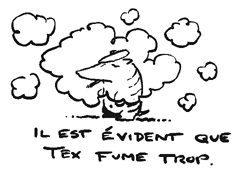|
|
A conjunction is a word used to link or 'conjoin' words or phrases into a coherent whole.
There are two classes of conjunctions: coordinate and subordinate.

coordinating conjunctions
A coordinating conjunction 'coordinates' two equivalent elements in a sentence, that is, words belonging to the same grammatical category
(nouns + nouns, verbs + verbs, independent clause + independent clause, etc.). The most commonly used coordinating conjunctions in French are:

| mais |
but |
| ou |
or |
| et |
and |
| donc |
so, thus |
| or |
so, now |
| ni ... ni |
neither ... nor |
| car |
for |
| puis |
then |
Edouard n'aime ni le barbecue ni les hamburgers.
|
Edouard likes neither barbecue nor hamburgers.
|
| Tex fume des cigarettes et boit du vin rouge. |
Tex smokes cigarettes and drinks red wine. |

subordinating conjunctions
A subordinating conjunction links an independent clause to a dependent clause.
In other words, a subordinating conjunction joins two unequivalent clauses (independent and dependent).
An independent clause is any clause that can stand alone to form a grammatical sentence.
A dependent clause, on the other hand, cannot stand alone and thus 'depends' on the main clause in order to form a complete thought.

The most commonly used subordinate conjunctions:
|
 |
| que |
that |
| pendant que |
as, while |
| quand |
when |
| lorsque |
when |
| depuis que |
since (indicating time) |
| tandis que |
while, whereas |
| puisque |
since |
| parce que |
because |
Il est évident que Tex fume trop.
(dependent) . ... .(independent) |
It is obvious that Tex smokes too much. |
|
|
|
|